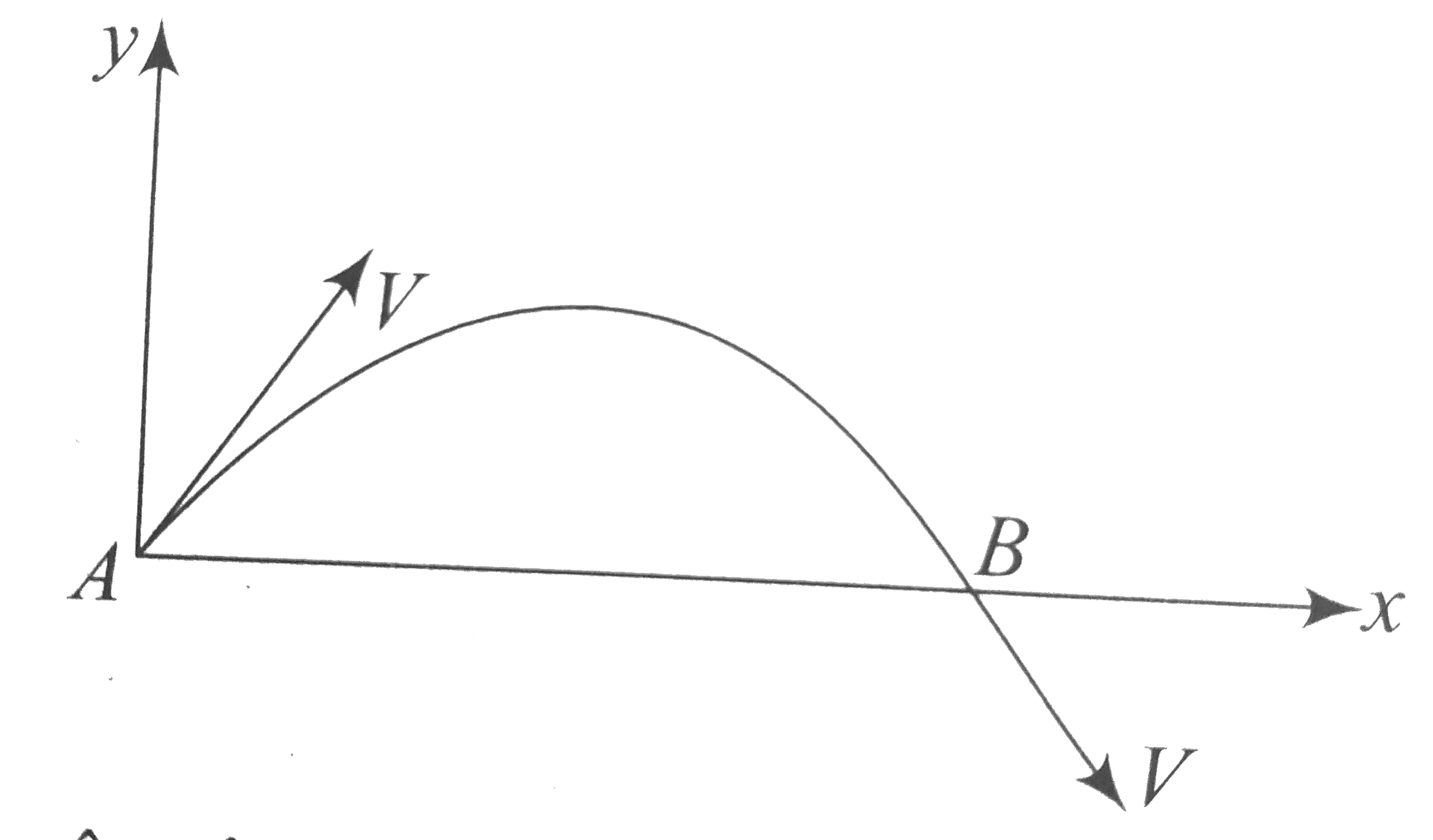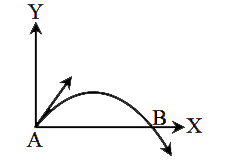Velocity of a projectile at height 15m from ground is v=(20ˆi+10ˆj)m/s. Here ˆi is in horizontal direction and ˆj is vertically upwards. Then
Horizontal range of the ground is …………m
60
50
80
70
The correct Answer is:C
To find the horizontal range of the projectile given the velocity at a height of 15 m, we can follow these steps:
1. Identify the Given Information:
- The velocity of the projectile at a height of 15 m is given as →v=20^i+10^j m/s.
- Here, ^i represents the horizontal component and ^j represents the vertical component.
2. Extract the Components of Velocity:
- The horizontal component of velocity, vx=20 m/s.
- The vertical component of velocity, vy=10 m/s.
3. Use the Kinematic Equation to Find Initial Vertical Velocity:
- We can use the kinematic equation:
v2y=u2y+2ays
- Here, vy is the final vertical velocity (10 m/s), uy is the initial vertical velocity, ay is the acceleration due to gravity (-10 m/s², acting downwards), and s is the height (15 m).
- Rearranging gives:
u2y=v2y−2ays
- Substituting the known values:
u2y=102−2⋅(−10)⋅15
u2y=100+300=400
uy=√400=20 m/s
4. Determine the Horizontal Component of Initial Velocity:
- From the given data, we already know ux=20 m/s.
5. Calculate the Time of Flight to Reach the Ground:
- The time to reach the maximum height can be calculated using:
t=uyg
- For uy=20 m/s and g=10 m/s²:
t=2010=2 seconds
- The total time of flight will be double this (up and down):
T=2t=2⋅2=4 seconds
6. Calculate the Horizontal Range:
- The horizontal range R can be calculated using:
R=ux⋅T
- Substituting the values:
R=20⋅4=80 meters
Final Answer:
The horizontal range of the projectile is 80 meters.
---
- The velocity of the projectile at a height of 15 m is given as →v=20^i+10^j m/s.
- Here, ^i represents the horizontal component and ^j represents the vertical component.
- The horizontal component of velocity, vx=20 m/s.
- The vertical component of velocity, vy=10 m/s.
- We can use the kinematic equation:
v2y=u2y+2ays
- Here, vy is the final vertical velocity (10 m/s), uy is the initial vertical velocity, ay is the acceleration due to gravity (-10 m/s², acting downwards), and s is the height (15 m).
- Rearranging gives:
u2y=v2y−2ays
- Substituting the known values:
u2y=102−2⋅(−10)⋅15
u2y=100+300=400
uy=√400=20 m/s
- From the given data, we already know ux=20 m/s.
- The time to reach the maximum height can be calculated using:
t=uyg
- For uy=20 m/s and g=10 m/s²:
t=2010=2 seconds
- The total time of flight will be double this (up and down):
T=2t=2⋅2=4 seconds
- The horizontal range R can be calculated using:
R=ux⋅T
- Substituting the values:
R=20⋅4=80 meters
The horizontal range of the projectile is 80 meters.
Topper's Solved these Questions
- KINEMATICSBOOK - DC PANDEY ENGLISHCHAPTER - KINEMATICSEXERCISE - MATCH THE COLUMN
3 Videos
- KINEMATICSBOOK - DC PANDEY ENGLISHCHAPTER - KINEMATICSEXERCISE - INTEGER_TYPE
10 Videos
- KINEMATICSBOOK - DC PANDEY ENGLISHCHAPTER - KINEMATICSEXERCISE - MCQ_TYPE
23 Videos
- GRAVITATIONBOOK - DC PANDEY ENGLISHCHAPTER - GRAVITATIONEXERCISE - (C) Chapter Exercises
45 Videos
- KINEMATICS 1BOOK - DC PANDEY ENGLISHCHAPTER - KINEMATICS 1EXERCISE - INTEGER_TYPE
15 Videos
Similar Questions
Velocity of a projectile at height 15m from ground is v=(20ˆi+10ˆj)m/s. Here ˆi is in horizontal direction and ˆj is vertically upwards. Then
Angle of projectile with ground is
View SolutionVelocity of a projectile at height 15m from ground is v=(20ˆi+10ˆj)m/s. Here ˆi is in horizontal direction and ˆj is vertically upwards. Then
Maximum height from a ground is ……..m
View SolutionVelocity of a projectile at height 15m from ground is v=(20ˆi+10ˆj)m/s. Here ˆi is in horizontal direction and ˆj is vertically upwards. Then
Speed with which particle is projected from ground is……… m/s
View SolutionA particle is projected from gound At a height of 0.4 m from the ground, the velocity of a projective in vector form is →v=(6ˆi+2ˆj)m/s (the x-axis is horizontal and y-axis is vertically upwards). The angle of projection is (g=10m/s2)
View SolutionAt a height of 15 m from ground velocity of a projectile is v=(10ˆi+10ˆj). Here ˆj is vertically upwards and ˆi is along horizontal direction then (g = 10 ms−1)
View SolutionAssertion At height 20 m from ground , velocity of a projectile is v=(20ˆi+10ˆj)ms−1. Here, ˆi is horizontal and ˆj is vertical. Then, the particle is at the same height after 4s.
Reason Maximum height of particle from ground is 40m (take, g=10ms−2)
View SolutionThe velocity of a projectile at the initial point A is (2ˆi+3ˆj)m/s. Its velocity (in m/s) at point B is

View SolutionThe velocity of a projectile at the initial point A is (2ˆi+3ˆj)ms. It's velocity (in m/s) at point B is -

View SolutionVelocity of a particle changes from (3ˆi+4ˆj)m/s to (6ˆi+5ˆj)m/s 2s. Find magnitude and direction of average acceleration.
View SolutionFrom the ground, a projectile is fired at an angle of 60 degree to the horizontal with a speed of 20 m s−1 The horizontal range of the projectile is
View Solution
